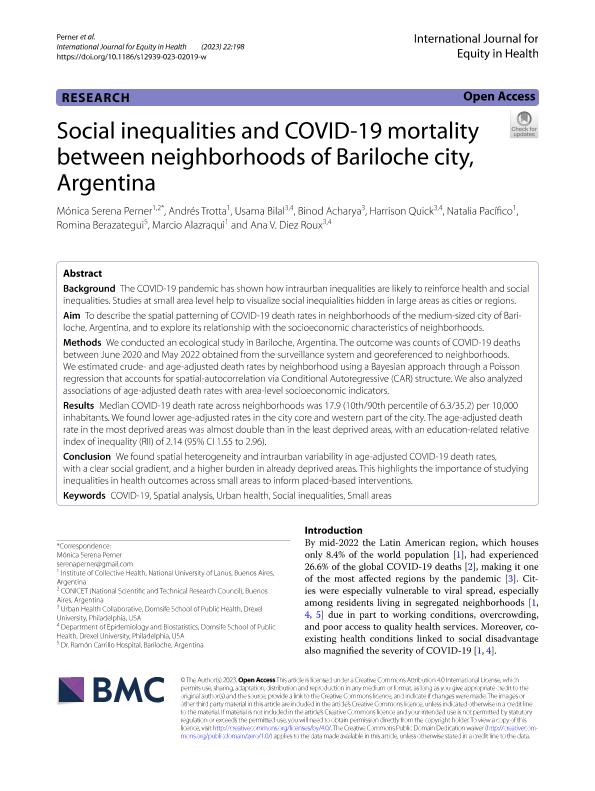Artículo
Social inequalities and COVID-19 mortality between neighborhoods of Bariloche city, Argentina
Perner, Mónica Serena ; Trotta, Andrés; Bilal, Usama; Acharya, Binod; Quick, Harrison; Pacífico, Natalia; Berazategui, Romina; Alazraqui, Marcio; Diez Roux, Ana Victoria
; Trotta, Andrés; Bilal, Usama; Acharya, Binod; Quick, Harrison; Pacífico, Natalia; Berazategui, Romina; Alazraqui, Marcio; Diez Roux, Ana Victoria
 ; Trotta, Andrés; Bilal, Usama; Acharya, Binod; Quick, Harrison; Pacífico, Natalia; Berazategui, Romina; Alazraqui, Marcio; Diez Roux, Ana Victoria
; Trotta, Andrés; Bilal, Usama; Acharya, Binod; Quick, Harrison; Pacífico, Natalia; Berazategui, Romina; Alazraqui, Marcio; Diez Roux, Ana Victoria
Fecha de publicación:
09/2023
Editorial:
BioMed Central Ltd
Revista:
International Journal for Equity in Health
ISSN:
1475-9276
Idioma:
Inglés
Tipo de recurso:
Artículo publicado
Clasificación temática:
Resumen
Background: The COVID-19 pandemic has shown how intraurban inequalities are likely to reinforce health and social inequalities. Studies at small area level help to visualize social inequialities hidden in large areas as cities or regions. Aim: To describe the spatial patterning of COVID-19 death rates in neighborhoods of the medium-sized city of Bariloche, Argentina, and to explore its relationship with the socioeconomic characteristics of neighborhoods. Methods: We conducted an ecological study in Bariloche, Argentina. The outcome was counts of COVID-19 deaths between June 2020 and May 2022 obtained from the surveillance system and georeferenced to neighborhoods. We estimated crude- and age-adjusted death rates by neighborhood using a Bayesian approach through a Poisson regression that accounts for spatial-autocorrelation via Conditional Autoregressive (CAR) structure. We also analyzed associations of age-adjusted death rates with area-level socioeconomic indicators. Results: Median COVID-19 death rate across neighborhoods was 17.9 (10th/90th percentile of 6.3/35.2) per 10,000 inhabitants. We found lower age-adjusted rates in the city core and western part of the city. The age-adjusted death rate in the most deprived areas was almost double than in the least deprived areas, with an education-related relative index of inequality (RII) of 2.14 (95% CI 1.55 to 2.96). Conclusion: We found spatial heterogeneity and intraurban variability in age-adjusted COVID-19 death rates, with a clear social gradient, and a higher burden in already deprived areas. This highlights the importance of studying inequalities in health outcomes across small areas to inform placed-based interventions.
Palabras clave:
COVID-19
,
SMALL AREAS
,
SOCIAL INEQUALITIES
,
SPATIAL ANALYSIS
,
URBAN HEALTH
Archivos asociados
Licencia
Identificadores
Colecciones
Articulos(SEDE CENTRAL)
Articulos de SEDE CENTRAL
Articulos de SEDE CENTRAL
Citación
Perner, Mónica Serena; Trotta, Andrés; Bilal, Usama; Acharya, Binod; Quick, Harrison; et al.; Social inequalities and COVID-19 mortality between neighborhoods of Bariloche city, Argentina; BioMed Central Ltd; International Journal for Equity in Health; 22; 1; 9-2023; 1-11
Compartir
Altmétricas



